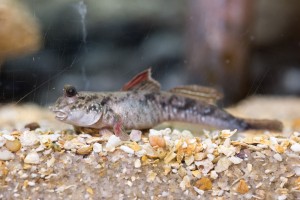 Could a tail have allowed ancient vertebrates to make the transition from water to land?
Could a tail have allowed ancient vertebrates to make the transition from water to land?
Researchers from Georgia Institute of Technology, Carnegie Mellon University, Clemson University and the National Institute for Mathematical and Biological Synthesis report in the journal Science this week on the results of a groundbreaking study to answer this question using amphibious fish, robots and mathematical models of movement.
The study tested the hypothesis that coordinated tail movement played an important role in the evolution of terrestrial vertebrates. The researchers found that, for the first critical step out of an aqueous environment and onto a riverbank or mudflat, stabilizing the body with a tail provided substantial benefits.
The effort, supported by the National Science Foundation (NSF), the Army Research Office, the Army Research Laboratory and the Robotics Collaborative Technology Alliance, brought together experts in physics, biology, robotics and mathematics who combined their expertise to explore the question, using the African mudskipper fish, a robot modeled after the fish and mathematical models.
“Most robots have trouble moving on terrain that includes sandy slopes,” said Dan Goldman, an associate professor in the Georgia Tech School of Physics. “We noted that not only did the mudskippers use their limbs to propel themselves in a kind of crutching motion on sand and sandy slopes, but that when the going got tough, they used their tails in concert with limb propulsion to ascend a slope. Our robot model was only able to climb sandy slopes when it similarly used its tail in coordination with its appendages.”
Based on fossil records, scientists have long studied how early land animals may have gotten around, and the new study suggests their tails – which played a key role in swimming as fish – may have helped supplement the work of fins, especially on sloping granular surfaces such as beaches and mudflats.
“Our computer modeling tools allow us to visualize, and therefore better understand, how the mudskipper incorporates its tail and flipper motions to locomote,” said Howie Choset, a professor in the Robotics Institute at Carnegie Mellon. “This work also will advance robotics in those cases where a robot needs to surmount challenging terrains with various inclinations.”
The lab of Richard Blob, alumni distinguished professor of biological sciences at Clemson University, recorded how the mudskippers moved on a variety of loose surfaces, providing data and video to Goldman’s laboratory. The small fish, which uses its front fins and tail to move on land, lives in tidal areas near shore, spending time in the water and on sandy and muddy surfaces.
Georgia Tech applied the Clemson mudskipper data to an electrically powered robot, known as MuddyBot, that has two limbs and a powerful tail. Information from both the mudskipper and robotic studies also were factored into a mathematical model provided by researchers at Carnegie Mellon.
Choset and Chaohui Gong, a CMU post-doctoral researcher, who have worked with Goldman on relating the locomotion of other animals to robots, demonstrated that theoretical models developed to describe the complex motion of robots also can be used to understand locomotion in the natural world.
“Professor Goldman and his collaborators are combining physics and engineering prototyping approaches to understand the physical principles that allow animals to move in different environments,” said Krastan Blagoev, program director in the National Science Foundation’s Division of Physics. “This novel approach to living organisms promises to bring to biological sciences higher predictive power and at the same time uncover engineering principles that we have never imagined before.”